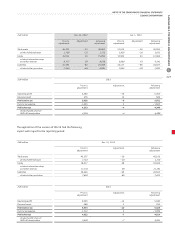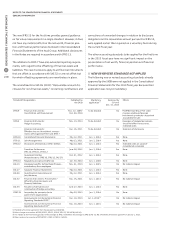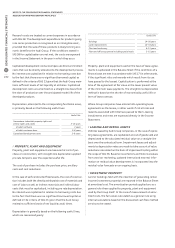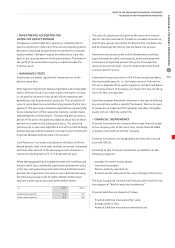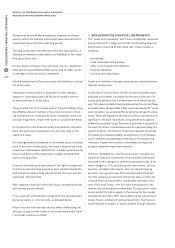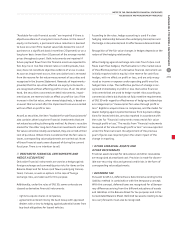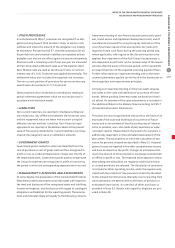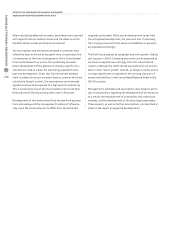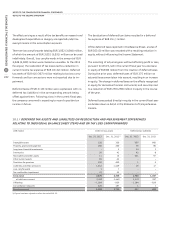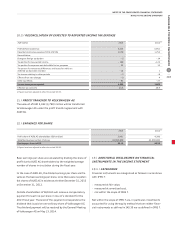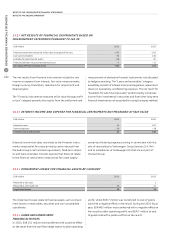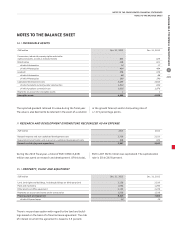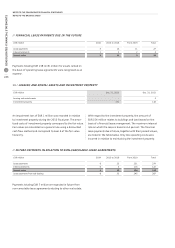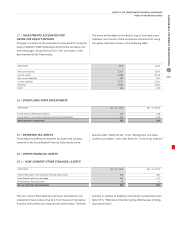Audi 2013 Annual Report Download - page 240
Download and view the complete annual report
Please find page 240 of the 2013 Audi annual report below. You can navigate through the pages in the report by either clicking on the pages listed below, or by using the keyword search tool below to find specific information within the annual report.
NOTES TO THE CONSOLIDATED FINANCIAL STATEMENTS
RECOGNITION AND MEASUREMENT PRINCIPLES
CONSOLIDATED FINANCIAL STATEMENTS
237
B
/
OTHER PROVISIONS
In accordance with IAS 37, provisions are recognized if an obli-
gation existing toward third parties is likely to lead to cash
outflows and where the amount of the obligation can reliably
be estimated. Pursuant to IAS 37, the other provisions for all
discernible risks and uncertain liabilities are reported at their
probable cost and are not offset against recourse entitlements.
Provisions with a remaining term of over one year are measured
at their discounted settlement value as of the balance sheet
date. Market rates are used as the discount rates. A nominal
interest rate of 1.0 (0.7) percent was applied domestically. The
settlement value also includes the expected cost increases.
The non-current portions of provisions for service anniversary
awards were discounted at 3.7 (3.2) percent.
Other provisions also include bonus contributions relating to
partial retirement agreements which are accrued pro rata in
accordance with the block model.
/
LIABILITIES
Non-current liabilities are reported in the Balance Sheet at
amortized cost. Any differences between the historical costs
and the repayment value are taken into account using the
effective interest method. Liabilities from financial lease
agreements are reported in the Balance Sheet at the present
value of the leasing installments. Current liabilities are recog-
nized at the repayment value or settlement amounts.
/
GOVERNMENT GRANTS
Government grants related to assets are deducted from the
cost of purchase or cost of goods sold and thus recognized in
profit or loss as a reduced depreciation charge over the life of
the depreciable asset. Government grants paid to compensate
the Group for expenses are recognized in profit or loss during
the period in which the corresponding expenses were incurred.
/
MANAGEMENT’S ESTIMATES AND ASSESSMENTS
To some degree, the preparation of the Consolidated Financial
Statements entails assumptions and estimates with regard to
the level and disclosure of the recognized assets and liabilities,
income and expense, and disclosures with regard to contingent
obligations and liabilities for the reporting period. The assump-
tions and estimates relate principally to the following contents:
Impairment testing of non-financial assets (particularly good-
will, brand names and capitalized development costs) and of
investments accounted for using the equity method or at the
cost of purchase requires that assumptions be made with
regard to future cash flows during the planning period and,
where applicable, with regard to the discounting rate to be
applied. Any impairment of the Audi Group’s leased assets is
also dependent in particular on the residual value of the leased
vehicles after the expiry of the lease period, as this represents
an essential portion of the expected incoming payment flows.
Further information on impairment testing and on the meas-
urement parameters applied can be found in the disclosures on
the recognition and measurement principles.
Carrying out impairment testing on financial assets requires
estimates on the scale and likelihood of occurrence of future
events. Where possible, these estimates are based on histori-
cal values. An overview of the value adjustments is included in
the additional Notes to the Balance Sheet according to IFRS 7
(Financial Instruments: Disclosures).
Provisions are also recognized and measured on the basis of an
estimate of the scale and likelihood of occurrence of future
events and on an estimate of the discounting rate of interest.
As far as possible, use is also made of past experience or exter-
nal expert reports. Measurement of provisions for pensions is
additionally dependent on the estimated development of the
plan assets. The assumptions on which the calculation of pro-
visions for pensions is based are described in Note 31. Actuarial
gains or losses are reported in the other comprehensive income
and have no impact on the profit. Changes to estimates relat-
ing to the amount of other provisions are always recorded with
an effect on profit or loss. The expected value approach means
that subsequent allocations are regularly made to provisions
or unused provisions are released. The dissolution of provisions
is recorded as other operating income, while the expense asso-
ciated with the creation of new provisions is directly allocated
to the relevant functional area. Warranty claims resulting from
sales operations are determined on the basis of previous or
estimated future losses. An overview of other provisions is
provided in Note 33. Details with regard to litigation are pro-
vided in Note 40.


